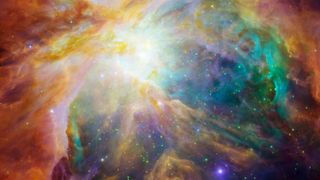James Webb Space Telescope spots dozens of physics-breaking rogue objects floating through space in pairs
Astronomers spotted Jupiter-mass binary objects (JUMBOs) in the Orion constellation, and they don't know how the objects formed.

The James Webb Space Telescope has discovered dozens of seemingly physics-breaking rogue objects floating through space in pairs, and scientists aren't sure how they can exist.
Freely drifting through the Orion Nebula, the Jupiter-mass binary objects, or "JuMBOs" exist in 42 pairs. Each object orbits its partner at up to 390 times the distance between Earth and the sun.
The JuMBOs are too small to be stars, but as they exist in pairs, they are unlikely to be rogue planets ejected from solar systems. Yet somehow they still formed. The researchers published their findings Oct. 2 on the preprint database arXiv and have not yet been peer-reviewed.
"How pairs of young planets can be ejected simultaneously and remain bound, albeit weakly at relatively wide separations, remains quite unclear," the researchers wrote in the paper. They suggest that "perhaps a new, quite separate formation mechanism," could be responsible for the odd couples' creation.
The rogue pairs are drifting through the Orion Nebula, a star-forming region roughly 1,344 light-years from Earth that features plumes of stormy gas pierced by beams of starlight. Observations from ground-based telescopes had previously alerted the researchers that other mysterious objects were also lurking in the gas cloud. Then, follow-up observations made with the James Webb Space Telescope finally spotted them.
The researchers' analysis revealed the strange objects are gas giants that are roughly a million years old with temperatures around 1,300 degrees Fahrenheit (700 degrees Celsius). Their billowing cloaks primarily consist of carbon monoxide, methane and steam.
Yet what truly baffled the astronomers is that many of the objects came in pairs.
Stars can take tens of millions of years to transform from collapsing clouds of cooling dust and gas to gently glowing protostars, before eventually coalescing into gigantic orbs of fusion-powered plasma like our sun.
As a star forms, it spins the gas cloud it's feeding on, weaving a disk of sprinkled leftovers from which planets can form. Sometimes this disk can prematurely split, seeding a glob of material that births a second star beside the first to create a binary system.
The theoretical lower limit for an object to form from star-like cloud-collapse is roughly three Jupiter masses — anything smaller should be born tethered to a star. This makes the existence of these pairs (which each have masses close to one Jupiter) hard to explain. They are possibly ejected planets, but how their binary relationship survived being spat out from their solar system is unclear. Alternatively, they could be a new category of failed stars, but how they became so small is a mystery.
"The ensemble of planetary mass objects and JuMBOs that we see in the Trapezium Cluster might arise from a mix of both of these 'classical' scenarios, even if both have significant caveats," the researchers wrote. "Or perhaps a new, quite separate formation mechanism, such as a fragmentation of a star-less disk, is required."
Sign up for the Live Science daily newsletter now
Get the world’s most fascinating discoveries delivered straight to your inbox.

Ben Turner is a U.K. based staff writer at Live Science. He covers physics and astronomy, among other topics like tech and climate change. He graduated from University College London with a degree in particle physics before training as a journalist. When he's not writing, Ben enjoys reading literature, playing the guitar and embarrassing himself with chess.
-
jfq722 I wonder what color the astronomers will just make up for these rogue objects in the name of science?Reply -
njones0100 "Physics breaking" is definitely a nonsense, garbage, click-bait headline.Reply
If we see something we don't understand the physics of, it doesn't "break" physics – nothing can. It simply means our understanding of physics is incomplete – which we already know. -
jfq722 Reply
I wasn't talking religion though. I'm just pissed that all the Webb photos are essentially "doctored" to supply these extravagant colors that absolutely do not exist on the actual objects themselves. I understand that without doing that they would all just be gray and black. That's fine - give me gray and black. I'd much rather see that then some fanciful BS designed to make people go oooohhh and ahhhh.Daaddski1 said:Lol scientists…. If you could just wrap your mind around the first 5 words in the most important book we have , your mysteries would be honest and far greater in understanding something…, oh.:. What book? What five words…. Here they are, are u ready? Are u sure u can handle truth? It explains how these rogus and the rest were created…. Okok here ya go…… drum roll please…. Dunh da da daaaaaa…
“IN THE BEGINNING …….GOD CREATED”
There you go…. Even explains how life began….. can you accept reality?
Now, with the above in mind… Go to work tomorrow with renued vigor and be happy. With your new knowledge in tact…. Learn HOW HE did all these things and report back to us. You know, the 95 pct of mankind that believes this to be exactly true…👍 -
cecilia fx Reply
I guess you don't realize that what we see as colors in these images are actually representing chemical data. Since humans can only physically observe a small amount of frequences, this allows us to "see" stars and nebulas in another way. It's not just "made up"jfq722 said:I wonder what color the astronomers will just make up for these rogue objects in the name of science? -
jfq722 Reply
No offense, but if I could snap my fingers and stand before one of these objects - If I wouldn't see the colors represented in these photos then they ARE made up. There are only two options: the colors are there in real life or they are not. Anything else is justification. If astronomers need the added color to further thier work, that's understandable. Then they alone should have access to the colored pictures. When the colors are issued to the public, I'm sorry - that is misleading and smacks of advertising for future funding.cecilia fx said:I guess you don't realize that what we see as colors in these images are actually representing chemical data. Since humans can only physically observe a small amount of frequences, this allows us to "see" stars and nebulas in another way. It's not just "made up" -
cecilia fx Reply
there's nothing misleading about these images. I'm not a scientist and no one special and I know what they mean. And science is ALL about finding information, data, and so on.jfq722 said:No offense, but if I could snap my fingers and stand before one of these objects - If I wouldn't see the colors represented in these photos then they ARE made up. There are only two options: the colors are there in real life or they are not. Anything else is justification. If astronomers need the added color to further thier work, that's understandable. Then they alone should have access to the colored pictures. When the colors are issued to the public, I'm sorry - that is misleading and smacks of advertising for future funding.
We, the human public, deserve to know and to see what's going on.
If you prefer to remain ignorant - fine. No one is forcing you to read this article or see the images. -
AAAJMA Reply
While human eyes are limited to seeing colors from red to violet, snakes can see beyond red (infrared). If you face a snake, open your mouth and raise your arms (shirtless) it would see your eyes, mouth and armpits as a different color than other parts of your body. Colors are just different frequencies of electromagnetic radiation. NASA has a telescope recording the sun in four ultraviolet frequencies. A section of image at 195 angstroms (1.5 million degrees Kelvin) has a color just as real as your shirt at 5171 angstroms which you would call green.jfq722 said:I wonder what color the astronomers will just make up for these rogue objects in the name of science? -
Bruzote I am always disappointed when cosmologists say clouds can only collapse into certain size objects. As if clouds don't have varying sizes and constituent distributions. Just because a fool's model has been limited to an artificial range of parameters does not mean nature is that limited. Any type of dust cloud can and should be expected in the infinitude of space. A small cloud given enough time can radiate heat and collapse. Depending on the motions within the cloud, it can form one or more centers of accumulating mass. That's just common sense.Reply
Most Popular

By Harry Baker

By Deepa Jain

By Tom Metcalfe

By Deepa Jain